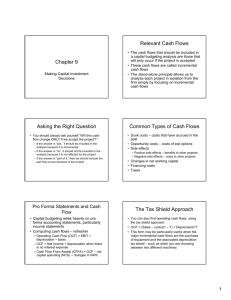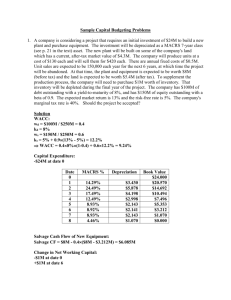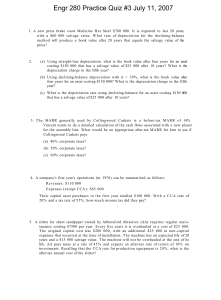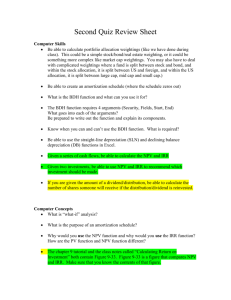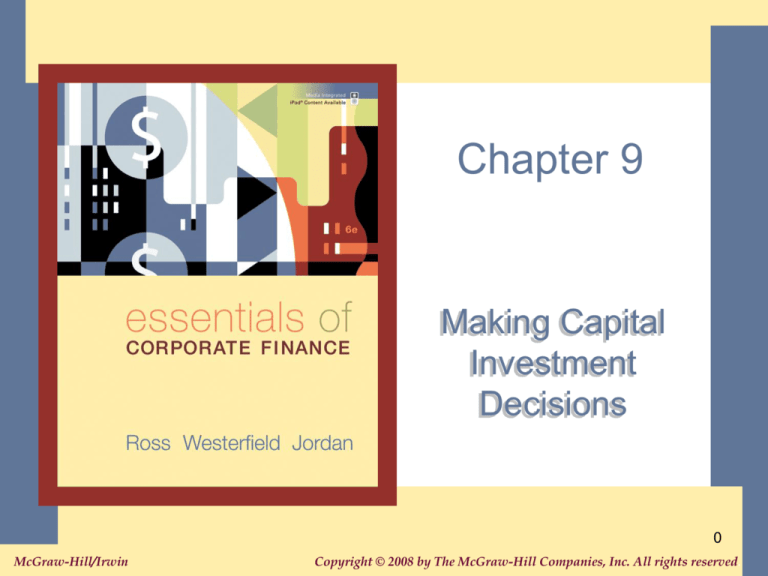
Chapter 9
Making Capital
Investment
Decisions
0
McGraw-Hill/Irwin
Copyright © 2008 by The McGraw-Hill Companies, Inc. All rights reserved.
1-1 9-1
Key Concepts and Skills
• Understand how to determine the relevant
cash flows for a proposed investment
• Understand how to analyze a project’s
projected cash flows
• Understand how to evaluate an estimated
NPV
1
1-2 9-2
Chapter Outline
• Project Cash Flows: A First Look
• Incremental Cash Flows
• Pro Forma Financial Statements and
Project Cash Flows
• More on Project Cash Flows
• Evaluating NPV Estimates
• Scenario and Other What-If Analyses
• Additional Considerations in Capital
Budgeting
2
1-3 9-3
Relevant Cash Flows
• The cash flows that should be included
in a capital budgeting analysis are those
that will only occur if the project is
accepted
• These cash flows are called incremental
cash flows
• The stand-alone principle allows us to
analyze each project in isolation from
the firm simply by focusing on
incremental cash flows
3
1-4 9-4
Asking the Right Question
• You should always ask yourself “Will this
cash flow change ONLY if we accept the
project?”
– If the answer is “yes,” it should be included
in the analysis because it is incremental
– If the answer is “no,” it should not be
included in the analysis because it is not
affected by the project
– If the answer is “part of it,” then we should
include the part that occurs because of the
project
4
1-5 9-5
Common Types of Cash Flows
• Sunk costs – costs that have accrued in
the past
• Opportunity costs – costs of lost options
• Side effects
– Positive side effects – benefits to other projects
– Negative side effects – costs to other projects
• Changes in net working capital
• Financing costs
• Taxes
5
Pro Forma Statements and
Cash Flow
1-6 9-6
• Capital budgeting relies heavily on pro forma
accounting statements, particularly income
statements
• Computing cash flows – refresher
– Operating Cash Flow (OCF) = EBIT + depreciation –
taxes
– OCF = Net income + depreciation when there is no
interest expense
– Cash Flow From Assets (CFFA) = OCF – net capital
spending (NCS) – changes in NWC
6
Table 9.1 Pro Forma Income
Statement
Sales (50,000 units at $4.00/unit)
$200,000
Variable Costs ($2.50/unit)
125,000
Gross profit
$ 75,000
Fixed costs
12,000
Depreciation ($90,000 / 3)
30,000
EBIT
Taxes (34%)
Net Income
1-7 9-7
$ 33,000
11,220
$ 21,780
7
1-8 9-8
Table 9.2 Projected Capital
Requirements
Year
0
NWC
Net Fixed
Assets
Total
Investment
1
2
3
$20,000
$20,000
$20,000
$20,000
90,000
60,000
30,000
0
$110,000
$80,000
$50,000
$20,000
8
1-9 9-9
Table 9.5 Projected Total Cash
Flows
Year
0
OCF
1
$51,780
Change in
NWC
-$20,000
Capital
Spending
-$90,000
CFFA
-$110,00
2
$51,780
3
$51,780
$20,000
$51,780
$51,780
$71,780
9
1-10
9-10
Making the Decision
• Now that we have the cash flows, we can
apply the techniques that we learned in
chapter 8
• Enter the cash flows into the calculator and
compute NPV and IRR
– CF0 = -110,000; C01 = 51,780; F01 = 2; C02 = 71,780
– NPV; I = 20; CPT NPV = 10,648
– CPT IRR = 25.8%
• Should we accept or reject the project?
10
1-11
9-11
The Tax Shield Approach
• You can also find operating cash flows
using the tax shield approach
• OCF = (Sales – costs)(1 – T) +
Depreciation*T
• This form may be particularly useful when
the major incremental cash flows are the
purchase of equipment and the associated
depreciation tax shield – such as when you
are choosing between two different
machines
11
1-12
9-12
More on NWC
• Why do we have to consider changes in
NWC separately?
– GAAP requires that sales be recorded on the income
statement when made, not when cash is received
– GAAP also requires that we record cost of goods sold
when the corresponding sales are made, regardless
of when we actually pay our suppliers
– So, cash flow timing differences exist between the
purchase of inventory, revenue and costs from its sale
on the income statement, and the actual cash
collection from its sale
12
1-13
9-13
Depreciation
• The depreciation expense used for
capital budgeting should be the
depreciation schedule required by the
IRS for tax purposes
• Depreciation itself is a non-cash
expense; consequently, it is only
relevant because it affects taxes
• Depreciation tax shield = DxT
– D = depreciation expense
– T = marginal tax rate
13
1-14
9-14
Computing Depreciation
• Straight-line depreciation
– D = (Initial cost – salvage) / number of years
– Very few assets are depreciated straight-line for tax
purposes
• MACRS
– Need to know which asset class is appropriate for tax
purposes
– Multiply percentage given in table by the initial cost
– Depreciate to zero
– Mid-year convention
14
1-15
9-15
After Tax Salvage
• If the salvage value is different from the
book value of the asset, then there is a tax
effect
• Book value = initial cost – accumulated
depreciation
• After tax salvage = salvage – T(salvage –
book value)
15
Example: Depreciation and
After-Tax Salvage
1-16
9-16
• You purchase equipment for $100,000 and it
costs $10,000 to have it delivered and
installed. Based on past information, you
believe that you can sell the equipment for
$17,000 when you are done with it in 6 years.
The company’s marginal tax rate is 40%.
What is the depreciation expense each year,
and the after tax salvage in year 6, for each
of the following situations?
16
Example: Straight-line
Depreciation
1-17
9-17
• Suppose the appropriate depreciation
schedule is straight-line
D = ($110,000 – 17,000) / 6 = $15,500 every
year for 6 years
BV in year 6 = $110,000 – 6(15,500) =
$17,000
After-tax salvage = $17,000 - .4(17,000 –
17,000) = $17,000
17
1-18
9-18
Example: Three-year MACRS
Year
MACRS
percent
D
1
.3333
.3333(110,000) =
36,663
2
.4444
.4444(110,000) =
48,884
3
.1482
.1482(110,000) =
16,302
4
.0741
.0741(110,000) =
8,151
BV in year 6 =
110,000 – 36,663 –
48,884 – 16,302 –
8,151 = 0
After-tax salvage
= 17,000 .4(17,000 – 0) =
$10,200
18
1-19
9-19
Example: Seven-Year MACRS
Year
MACRS
Percent
D
1
.1429
.1429(110,000) =
15,719
2
.2449
.2449(110,000) =
26,939
3
.1749
.1749(110,000) =
19,239
4
.1249
.1249(110,000) =
13,739
5
.0893
.0893(110,000) = 9,823
6
.0893
.0893(110,000) = 9,823
BV in year 6 =
110,000 – 15,719 –
26,939 – 19,239 –
13,739 – 9,823 –
9,823 = 14,718
After-tax salvage =
17,000 - .4(17,000
– 14,718) =
16,087.20
19
1-20
9-20
Example: Replacement Problem
• Original Machine
– Initial cost = 100,000
– Annual depreciation =
9,000
– Purchased 5 years ago
– Book Value = 55,000
– Salvage today = 65,000
– Salvage in 5 years =
10,000
• New Machine
–
–
–
–
Initial cost = 150,000
5-year life
Salvage in 5 years = 0
Cost savings = 50,000 per
year
– 3-year MACRS
depreciation
• Required return =
10%
• Tax rate = 40%
20
Replacement Problem –
Computing Cash Flows
1-21
9-21
• Remember that we are interested in
incremental cash flows
• If we buy the new machine, then we will
sell the old machine
• What are the cash flow consequences of
selling the old machine today instead of in
5 years?
21
Replacement Problem – Pro
Forma
Income
Statements
Year
1
2
3
4
5
Cost
Savings
1-22
9-22
50,000
50,000
50,000
50,000
50,000
49,995
66,660
22,230
11,115
0
9,000
9,000
9,000
9,000
9,000
40,995
57,660
13,230
2,115
(9,000)
EBIT
9,005
(7,660)
36,770
47,885
59,000
Taxes
3,602
(3,064)
14,708
19,154
23,600
NI
5,403
(4,596)
22,062
28,731
35,400
Depr.
New
Old
Increm.
22
•
Replacement Problem –
Incremental Net Capital
Spending
Year 0
1-23
9-23
– Cost of new machine = $150,000 (outflow)
– After-tax salvage on old machine = $65,000 .4(65,000 – 55,000) = $61,000 (inflow)
– Incremental net capital spending = $150,000
– 61,000 = $89,000 (outflow)
• Year 5
– After-tax salvage on old machine = $10,000 .4($10,000 – 10,000) = $10,000 (outflow
because we no longer receive this)
23
Replacement Problem – Cash
Flow From Assets
Year
0
OCF
1
46,398
2
53,064
3
35,292
4
30,846
5
26,400
NCS
-89,000
-10,000
In
NWC
0
0
CFFA
-89,000 46,398
53,064
35,292
30,846
1-24
9-24
16,400
24
Replacement Problem –
Analyzing the Cash Flows
1-25
9-25
• Now that we have the cash flows, we can
compute the NPV and IRR
– Enter the cash flows
– Compute NPV = $54,801.29
– Compute IRR = 36.27%
• Should the company replace the
equipment?
25
1-26
9-26
Evaluating NPV Estimates
• The NPV estimates are just that –
estimates
• A positive NPV is a good start – now we
need to take a closer look
– Forecasting risk – how sensitive is our NPV
to changes in the cash flow estimates; the
more sensitive, the greater the forecasting
risk
– Sources of value – why does this project
create value?
26
1-27
9-27
Scenario Analysis
• What happens to the NPV under different
cash flows scenarios?
• At the very least, look at:
– Best case – revenues are high and costs are low
– Worst case – revenues are low and costs are high
– Measure of the range of possible outcomes
• Best case and worst case are not
necessarily probable; they can still be
possible
27
1-28
9-28
Sensitivity Analysis
• What happens to NPV when we vary
one variable at a time
• This is a subset of scenario analysis
where we are looking at the effect of
specific variables on NPV
• The greater the volatility in NPV in
relation to a specific variable, the larger
the forecasting risk associated with that
variable and the more attention we want
to pay to its estimation
28
1-29
9-29
New Project Example
• Consider the project discussed in the
text
• The initial cost is $200,000 and the
project has a 5-year life. There is no
salvage. Depreciation is straight-line, the
required return is 12%, and the tax rate
is 34%
• The base case NPV is $15,567
29
1-30
9-30
Summary of Scenario Analysis
Scenario
Net
Income
Cash
Flow
NPV
IRR
Base case
$19,800
$59,800
$15,567
15.1%
Worst Case
-15,510
24,490
-111,719
-14.4%
Best Case
59,730
99,730
159,504
40.9%
30
1-31
9-31
Summary of Sensitivity Analysis
Scenario
Unit
Sales
Cash Flow
NPV
IRR
Base case
6,000
$59,800
$15,567
15.1%
Worst case
5,500
$53,200
-$8,226
10.3%
Best case
6,500
$66,400
$39,357
19.7%
31
1-32
9-32
Making A Decision
• Beware “Paralysis of Analysis”
• At some point, you have to make a
decision
• If the majority of your scenarios have
positive NPVs, then you can feel
reasonably comfortable about accepting
the project
• If you have a crucial variable that leads to a
negative NPV with a small change in the
estimates, then you may want to forgo the
project
32
1-33
9-33
Managerial Options
• Capital budgeting projects often provide
other options that we have not yet
considered
– Contingency planning
– Option to expand
– Option to abandon
– Option to wait
– Strategic options
33
1-34
9-34
Capital Rationing
• Capital rationing occurs when a firm or
division has limited resources
– Soft rationing – the limited resources are
temporary, often self-imposed
– Hard rationing – capital will never be available
for this project
• The profitability index is a useful tool when
faced with soft rationing
34
1-35
9-35
Quick Quiz
• How do we determine if cash flows are
relevant to the capital budgeting
decision?
• What is scenario analysis and why is it
important?
• What is sensitivity analysis and why is it
important?
• What are some additional managerial
options that should be considered?
35
1-36
9-36
Comprehensive Problem
• A $1,000,000 investment is depreciated
using a seven-year MACRS class life. It
requires $100,000 in additional inventory,
and will increase accounts payable by
$50,000. It will generate $400,000 in
revenue and $150,000 in cash expenses
annually, and the tax rate is 40%. What is
the incremental cash flow in years 0, 1, 7,
and 8?
36



